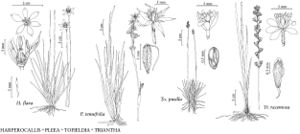Triantha racemosa
Fl. S.E. U.S., 249, 1328. 1903.
Stems leafless, or with 1–3 leaves towards base, 20–70 cm, coarsely glandular-pubescent below inflorescence. Leaf blades to 35 cm × 6 mm. Inflorescences racemose, 15–80-flowered, usually open, 3–22 cm; bracts subtending pedicel in cluster; bracteoles shallowly 3-lobed or cleft from proximal 1/3 to base, lobes acute or rounded, usually glandular. Flowers borne in clusters of (2–)3(–7), proximal sometimes remote; perianth white, drying orange; tepals 2.5–5 mm, inner series narrower, longer; stamens 2.5–4.5 mm; ovary ellipsoid to cylindrical, usually tapering abruptly to style base, forming rounded shoulder; styles connate basally into column 1/4–2/3 their length, 1–1.8 mm; pedicel 2–12 mm. Capsules ovoid to subglobose, 3–5 mm, ± equaling or slightly longer than tepals and ± enclosed by them, hard. Seeds reddish brown, ca. 1 mm; appendages 1 or 2 with one at one end ca. 1/2 to equaling seed, one at opposite end often much shorter; coat absent.
Phenology: Flowering summer.
Habitat: Boggy areas, pine barrens, savannas
Elevation: 0–400 m
Distribution

Ala., Del., D.C., Fla., Ga., La., Md., Miss., Tex., Va.
Discussion
Specimens of Triantha collected in Burlington County, New Jersey, have generally been determined as T. racemosa. However, the population is variable, and while there are aspects in some of these plants suggestive of T. racemosa that would explain the determinations, others are closer morphologically to T. glutinosa. This is seen in the typical “glutinosa” glands, the narrower, less-spreading bracteoles that usually lack glandular hairs, the more-ascending pedicels, the shorter internodes in most inflorescences, and the chartaceous capsules. I suppose that in the past the two species had overlapping ranges in this northeastern region where they no longer are found, and that some hybridization between T. glutinosa and T. racemosa has occurred. The Burlington County population is a surviving disjunct remnant with attributes of both species. The specimens have been annotated T. glutinosa × T. racemosa, and New Jersey is omitted from the list of states in which T. racemosa is found.
Selected References
None.
